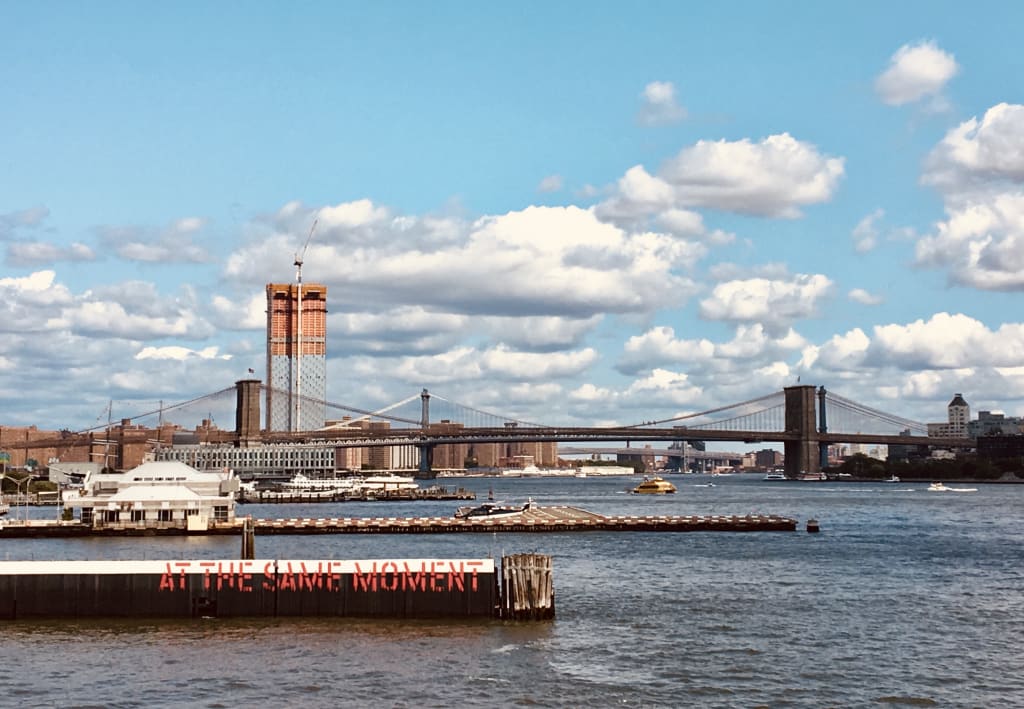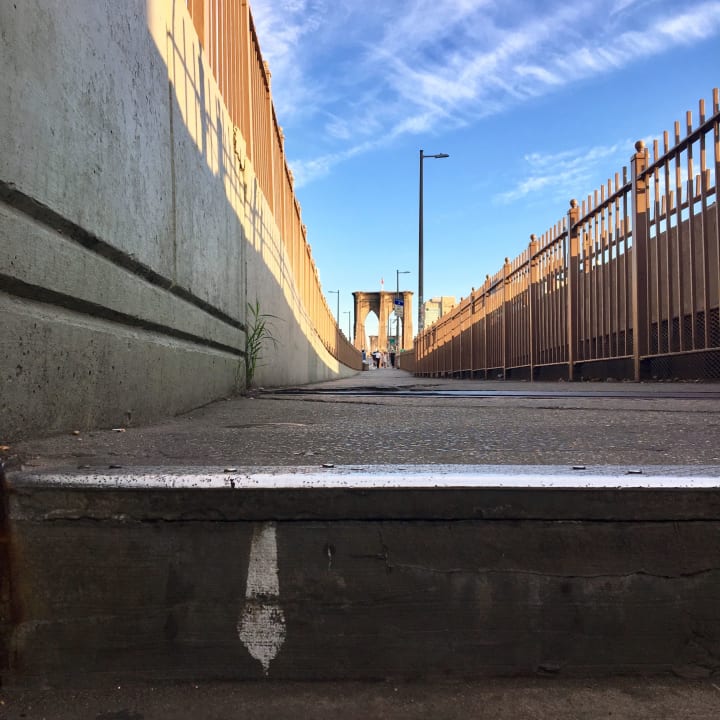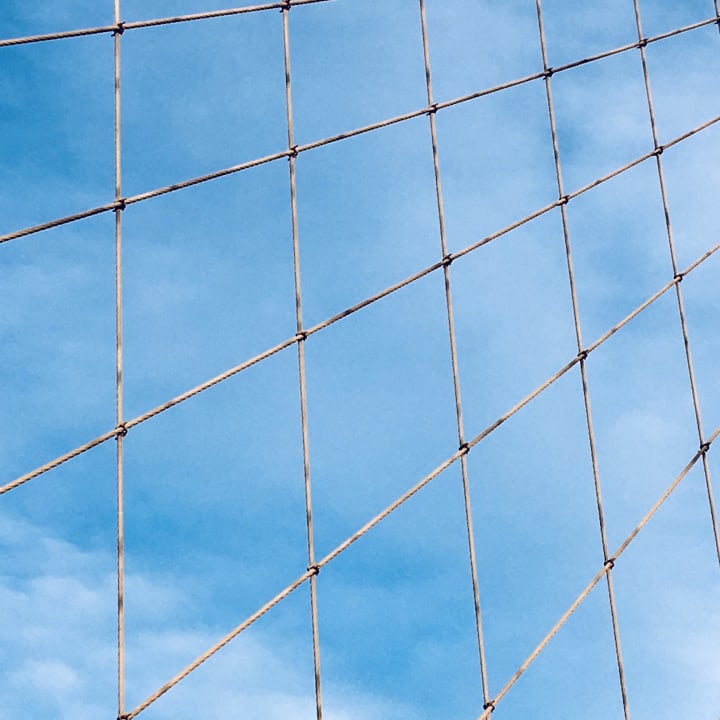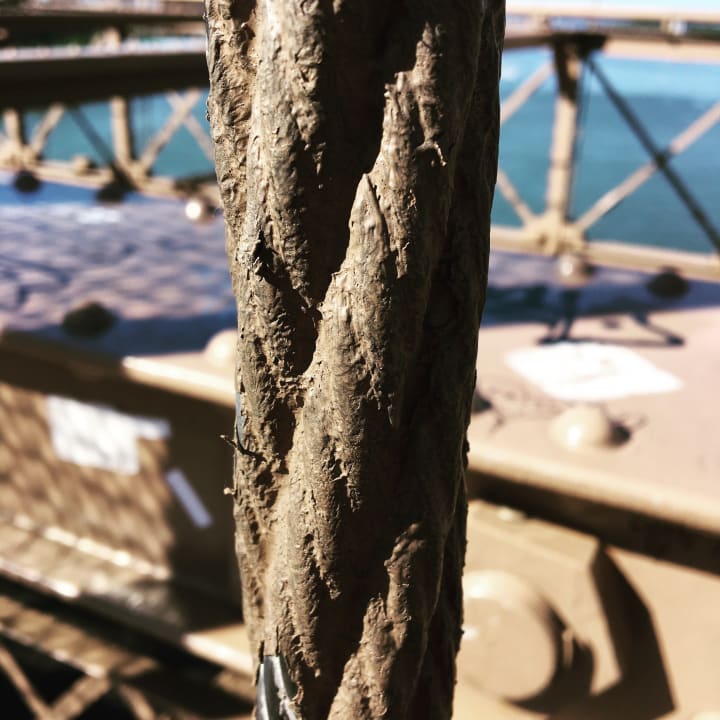A virtual walk across the Brooklyn Bridge
Even if you're in lockdown, the beauty of this wonder of the world awaits you. It's a structure I know and love, and I'd be thrilled to guide you across.

This is a public service announcement. Good morning! Good afternoon! Good evening! I really hope you’re well, and that everyone you love is well. This is tough stuff. It’s a pain to be stuck inside. It’s hard to worry about people and worry about the world. You’re in lockdown. You're self-isolating. You’re social-distancing. You feel cooped up, stir crazy and maybe a little scared. I know I am; I’m there with you. So: I’d like to invite you to take a walk with me, a walk across the Brooklyn Bridge.
I’ll come clean. I wrote a book about the man who built the bridge, Washington Roebling, so you could say I have an axe to grind, or indeed a book to sell. The book is called Chief Engineer, and you can buy it on Amazon or (even better) an independent bookstore. But the real truth is I’ve spent much of my life thinking about Wash (as he called himself, and as I call him) and his remarkable achievement. I grew up in New York, though I live in London now. I was sixteen when I first walked across the bridge and — let’s be frank — fell in love with the structure and then its builder. Here he is. This is the picture I’ve carried in my wallet for well over thirty years:

Pretty cute, no? W. A. R. — those are his initials, Washington Augustus Roebling. We have the same middle name — I’m Augusta — which I think is quite cool. Anyway, now you’ve met Wash, and you’ve met me. Off we go then — are you ready? Got your walking shoes on? We’re going to take the subway to High Street/Brooklyn Bridge. It’s the C train. A quick ride from wherever you are, I’m sure, whether you’re in London or Los Angeles. This is the bliss of virtual travel. Probably you’re ready for a cup of coffee after journey: once we’re up from underground, we’ll take a quick detour to Cranberry’s, on Henry Street, for a cup of Joe and – why not? a black-and-white cookie. Or a corn muffin. Or both. Hey, this is a virtual walk! You can have anything you want.

Right then. A sip of coffee, a bite of the cookie. Here we go. Back the way we came, at first, heading east towards Cadman Plaza so we can duck down towards the path that leads to the Bridge. Now, at this point you might want a little bit of background. Obviously you’ll find lots more of that in my book (yes! shameless plug!) but in brief: the Brooklyn Bridge was begun in 1869 and finished in 1883. Fourteen years to build — that sounds like a long time, and it is. Why? Because — though we take it for granted now as part of New York’s furniture — it was, at the time, a completely unprecedented structure. It was designed by Washington’s father, John Roebling, but he died in 1869, before any real work had been done, before very many plans had been made. When Wash took over, he was 32. At sixteen I thought that was mighty old. I don’t, anymore. It was the first bridge across the East River; it was the first bridge built using steel cables. A lot of people thought it couldn’t be built. It was a moonshot, a wonder.
Into Cadman Plaza Park, past Whitman Park — named for the Brooklyn poet Walt Whitman. “Crowds of men and women attired in the usual costumes, how curious you are to me!/ On the ferry-boats the hundreds and hundreds that cross, returning home, are more curious to me than you suppose,” he wrote in “Crossing Brooklyn Ferry” — before the Bridge, ferries were the only way to get from Brooklyn to Manhattan, then two separate cities. Seventy million journeys were made each year. But the ferries could be dangerous; when the river iced up, no one could cross at all.
Right this way. We head down under the bridge and —careful — don’t miss it — just there on your left, to the west, is a little hole in the wall, the entrance to a stairway that leads up to the bridge’s pedestrian promenade. Up we go.

The Brooklyn Bridge is most unusual in having a walkway that runs not beside the traffic, but over it. In a sense, pedestrians (and now, cyclists) have priority over cars: it’s those on foot who get the finest experience of the Bridge. That was its designer’s plan. In his proposal for the Bridge, John Roebling wrote of the promenade that “its principal use will be to allow people of leisure and old and young invalids, to promenade over the bridge on fine days, in order to enjoy the beautiful views and the fine air. I need not state that in a crowded commercial city, such a promenade will be of incalculable value.” And so it is for us today as we come to the top of the stairs and begin to see just what the Bridge has to offer us.

Ah! Here we go, beginning our rise over the river! What time is it? Morning’s the best, I think, but I have crossed the Bridge at every hour of the day and in the velvet darkness too, in sun and wind and rain. Standing in the sunshine with you, I call to mind a walk I made with my son in February 2012. We’d arrived from London the night before and were jet-lagged, up by 3 am, and so we set off from our borrowed apartment in Brooklyn Heights. It was freezing in the pre-dawn, the wind shoved against us, burrowed down our necks, the river was black dark. We had to lean into the wind; my son, who at 12 now thought he was too big to hold my hand, held my hand. A bitter and beautiful crossing. But today it’s warm and sunny. You might slip your sunglasses onto your nose; you might loosen your collar.
We’re not over the river just yet. We’re still on what is called the “land span” of the Bridge; the river span, the river itself, still ahead of us. We’re walking, feeling the gradient of the roadway as we move, just a little uphill. A nice breeze pushes its fingers through your hair, cools the dregs of your coffee; throw the cup in a garbage can now and stride out until —

— until I draw your attention to one of the four great cables, the wire wonders that suspend the Bridge above the river. John Roebling’s contribution to the industrial age was not confined to the development of the suspension bridge: his fortune was founded on the development and manufacture of wire rope. Which is exactly what it sounds like: rope made out of metal wire. Think you don’t care about wire rope? Think again. If you’ve ever been in an elevator, you care about wire rope. If you’ve ever been in a building built using big cranes, you care about wire rope. The telegraph, the telephone, airplanes and automobiles, all were made possible by the use of wire rope. And of course: the steel suspension bridge was made possible by the use of wire rope.
Look at this awesome piece of technology set against the bright blue sky! You’d like a few numbers? Of course. Each cable is just over 15 inches in diameter; there are five and a half thousand wires in each cable; the four cables cables together make up about 14,000 miles of wire. Each cable weighs just over 1.7 million pounds, and each was “spun” in place, laid in parallel strands over the river, and endless traveller going back and forth and back and forth, beginning in the summer of 1876; the process of making all four cables took a little over two years. Astonishingly, though the Bridge has undergone much reconstruction and restoration, the main cables are completely unchanged since the day of the Bridge’s opening on May 24, 1883. That they were designed to do a job in the 19th century which they can still perform in the 21st is an extraordinary tribute to the builders of the Bridge.
On we go. You’re getting some oxygen into your lungs now! We’re heading west towards Manhattan, the rising sun is at our backs; it gleams off One World Trade Center and I find myself recalling the other two buildings that used to stand there: so long ago now, it seems.
The promenade is made from wooden slats: as we move out onto the river span — just over 1500 feet long — you can look south and see a Staten Island Ferry moving through the water, there’s a schooner, there a group of Jet Skis, buzzing like wasps in the distance. Governor’s Island with its stone-built fortress. Look north towards the Manhattan and Williamsburg Bridges, younger siblings of the Brooklyn Bridge. The Williamsburg Bridge opened in 1903; the Manhattan Bridge six years later. By then Brooklyn and New York were no longer separate cities, all five boroughs having been consolidated into Greater New York in 1898.
If you look down through the slats — golly! You can see cars and taxis rushing back and forth beneath you, and you can even glimpse the river down there through the latticework of the roadway, the trusswork. Every single day, over 100,000 cars, 4,000 cyclists and 10,000 pedestrians cross the Bridge, according to New York’s Department of Transportation: today, you and I make two of those lucky walkers.

Now we’re going to have a little pause; you’re going to experience the real wonder of this bridge. Stop walking; stand still. Breathe in and out, look around. Feel the Bridge beneath your feet. Solid as anything, isn’t it? Those great stone towers ahead of you, those huge steel cables. A firm foundation. But now, pay attention to the latticework of smaller cables that hang down from the main cables and fan out from the towers: vertical suspenders, diagonal stays. They are what give the Bridge its distinctive spider-web look.

Now choose one of the vertical suspender cables. Look at it closely. It’s made from steel wire twisted like ordinary rope, not wires laid parallel as they are in the main cable. It looks a little battered, perhaps, but I assure you it’s still doing its job, holding up the Bridge.

Reach out. Wrap your hand around the wire: wrap both hands around it, like you’d hold a baseball bat. Just for a moment, close your eyes. There, can you feel that? The steel cable vibrating in your palm. Because the Bridge is never still. The Bridge is alive, adjusting itself to your weight, the weight of every car, every cyclist; shifting with the pressure of the wind. At the opening ceremony in 1883, Abram Hewitt — one of the politicians who brought the Bridge into being and later Mayor of New York — spoke to this very point. The Bridge, he said, “looks like a motionless mass of masonry and metal; but, as a matter of fact, it is instinct with motion. there is not a particle of matter in it which is at rest even for the minutest particle of time.” Instinct with motion — I have always loved that phrase. Just as every particle of matter in your own body moves, so moves the body of the Bridge, the stone of the towers in compression, the steel cables in tension, the two forces working with each other to hold the living structure above the river. What a wonder! And you can feel it there, right under your hand.

I have so many photographs of the Brooklyn Bridge. Every time I cross, I think: do I need another photograph of the Bridge? Surely not. But the Bridge is not only a vital piece of New York’s infrastructure: it is a work of art. A great many artists have responded to the Roeblings’ vision: O harp and altar, wrote Hart Crane in his great poem, “The Bridge: To Brooklyn Bridge.” (If you want to get a fine overview of what the Bridge has inspired, turn to Richard Haw’s book, Art of the Brooklyn Bridge.) And so I keep taking pictures, as if I could posses the Bridge, hold it in my pocket, take it away with me. Here we are, paused on this sunny day in front of the Brooklyn Tower. Those iconic, pointed Gothic arches were the vision of John Roebling: in archival drawings you can see other ideas he tried out before settling on this final design: the Bridge could have looked like an Egyptian temple!
John Roebling may have designed the Bridge: but it was left to his son Washington to build it. That would have been an awesome task at the best of times, it would be an awesome task today; but the Brooklyn Bridge was new technology, and Washington had to work out how to build the bridge as he went along. Henry Perahia, who for fifteen years was Chief Engineer and Chief Bridge Officer for the New York City Department of Transportation, said to me that “this is one of the few bridges where there were major changes to the design as it was being built — much of the engineering was done on the fly.”
I won’t go into all those changes here — we want to keep moving after all — but I will tell you that the greatest challenge in building this Bridge is completely invisible today. The great stone towers (each one just over 276 feet high) rest on foundations sunk deep into the bed of the East River, and laying those foundations was novel — and extremely dangerous — work. Hundreds of laborers had to toil, like deep sea divers, in compressed air, and as a result many of them became sick and some died, suffering from “the bends” or decompression sickness, as it is usually known today. Washington himself became very sick indeed: unable to leave his room, unable to read or write. But he had, as he put it, “a strong tower to lean upon”.

Emily Warren Roebling was Wash’s remarkable wife. The younger sister of his commanding officer during the Civil War, she became very much more than his good right hand. She was not an engineer: but she dealt not only with politicians and money-men, but also with Washington’s assistant engineers and contractors. She had, Washington would write, “a thorough knowledge of the work”. “Being assisted in these ways for fourteen long years with the various phases of the work,” he wrote, “she earned a well-deserved recognition as well as my everlasting gratitude.” It is quite right that she is memorialized on the Bridge: she was an absolutely vital part of its construction.
On we go, under the arch of the Brooklyn Tower. Some years ago I saw peregrine falcons nesting in the tower — are they still there? Let’s stop and have a look, while we breathe in the fresh air off the river.

The glories strung like beads on my smallest sights and hearings, on the walk in the street and the passage over the river,
The current rushing so swiftly and swimming with me far away,
The others that are to follow me, the ties between me and them,
The certainty of others, the life, love, sight, hearing of others.
… as Whitman wrote. What can you see? What can you feel? Perhaps there’s a couple in front of us, walking slowly, hand in hand; the Bridge is a place lovers love. The rush of air by your cheek as a cyclist races by. The call of a seagull, a fire engine’s distinctive wail carrying from the farther shore.

We’re heading down into Manhattan now, sloping down towards City Hall, the elegance of the Tweed Courthouse, the delicate spire of the Woolworth Building, its height echoing the Gothic arches of the Bridge. I feel the stretch in my legs as we walk together, as I look down over Water Street, towards South Street Seaport, as I think of New York’s history, its past, present and future, the multitudes it contains, the struggles of its citizens, our suffering, our joy. Wash knew suffering: he was a man of privilege, in many ways, but knew well the horrors of war; and his work on the Bridge nearly cost him his life. Yet he had an extraordinary ability to keep things in perspective. He was fascinated by geology; he knew what it meant to take the long view. “I know that nothing can be done perfectly at the first trial,” he said once. “I also know that each day brings its little quota of experiences, which with honest intentions, will lead to perfection after a while.”

Well then. Here we are, our morning crossing made. Manhattan awaits! I’ve so enjoyed this stroll with you; I wonder what’s next? Why sure — we could go for lunch in Chinatown; I’m totally up for that. I never turn down a noodle. The Bridge is behind us, and it’s time for our next adventure — but let’s cross again, another day. Look after yourself, look after those you love. Look after those you don't even know. We're all in this together. We are bridges between each other.

About the Creator
Erica Wagner
Lead Editorial Innovator, Vocal. Author, critic, friend, parent, cook. New book: Chief Engineer: Washington Roebling, The Man Who Built the Brooklyn Bridge. Twitter: @EricaWgnr, Insta: @ericawgnr






Comments
There are no comments for this story
Be the first to respond and start the conversation.